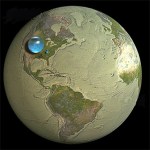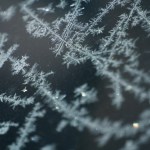water
"You don't drown by falling in the water; you drown by staying there." -Edwin Louis Cole
Our Solar System is -- at least from our perspective -- the most well-studied system of planets, moons, asteroids and comets in the entire Universe.
Image credit: Olaf Frohn, from earlier in 2012.
And in this system, the closest planet to our Sun, Mercury, was also one of the most poorly understood planets until very recently. Because Mercury is so close to the Sun, it's very difficult to view it under good conditions with a telescope; the risk of ruining your optics by exposing them to direct…
Check out this video of an archer fish (Toxotes jaculatrix) shooting down prey by creating a water jet:
Here it is again in slow motion:
Until now, the mechanism by which the archer fish produces such a powerful jet of water was a mystery. Contrary to prior hypotheses, the fish do not have specialized internal structures. Dr. Alberto Vailati and colleagues at the University of Milan filmed the fish and found that the initial jet of water travels at an impressive 2 meters per second and the lagging end of the water jet is actually faster. The end result: the head of the water jet is held…
Forty years ago today, the Clean Water Act was enacted. Since then, US waterways have gotten cleaner – but some people seem to be forgetting why we need regulation like this in the first place. The Act aimed "to restore and maintain the chemical, physical, and biological integrity of the Nation's waters" by establishing a system to regulate municipal, industrial, and other discharges into waterways. EPA explains:
The CWA set a new national goal “to restore and maintain the chemical, physical, and biological integrity of the Nation’s waters”, with interim goals that all waters be…
The term “floating water bridge” may sound nonsensical, but it’s the most logical name for a phenomenon that occurs when two beakers of water set slightly apart are zapped with high-voltage electricity and the water molecules jump across the gap to connect and form a thin thread of water. The molecular structure that suspends this liquid bridge has stumped scientists for over a century.
Now, a team of scientists has peered into floating water bridges with high-energy x-rays using the Advanced Photon Source (APS) at Argonne National Laboratory. Their work, “Floating water bridges and…
According to UN Water, "Each of us needs to drink 2 to 4 litres of water every day. But it takes 2000 to 5000 litres of water to produce one person's daily food." If that seems like a lot, it is. But it's funny how much depends on your perspective. A graphic from the USGS shows what it would look like if all the water on Earth were gathered into one drop. On A Few Things Ill-Considered, Coby Beck discusses the even smaller drop that represents all fresh water. Coby writes, "A full 74.5% of that much smaller ball is locked away in ice caps and glaciers and 24.7% is groundwater (much…
This image has been going around the intertubes recently, I saw it first on Planet 3.0 and again on APOD. It is one of those interesting illustrations of large quantities that seems surprising or anti-intuitive either because you never thought about it carefully before or just because it is hard to get your head around sizes that are so far outside the realm of everyday experience.
Anyway, I am posting it because my wife insisted (a very unusual turn of events, considering the usual frown upon spending my non-work time on the computer!). When she saw it she became quite alarmed and thought…
At Wonkblog, Brad Plumer highlights a new NBER paper that's disappointing to those who hoped that distributing cleaner cookstoves in India and other countries would be an easy way to improve respiratory health and help slow global warming. Many low-cost, traditional cookstoves belch soot, which is bad for the lungs of people who spend long hours near the stoves and for the ice that melts more quickly when soot particles settle on it. Cleaner stoves would improve respiratory health and could run on less fuel, and these changes could be of particular benefit to women, who often spend hours each…
Deborah Sontag's New York Times piece "Haiti's Cholera Outraced the Experts and Tainted the UN" is a reminder that while public attention to the earthquake-ravaged country has waned, cholera still presents a major threat to the country's people. It's also just a sad story about how one apparently small malfunction can have disastrous consequences for an entire nation.
The UN's independent experts concluded that the strain of cholera now afflicting Haitians had come from South Asia, and originated in the tributary behind a base used by Nepalese UN peacekeeiping troops, most likely from a…
Today is World Water Day, and this year's theme is "Water and Food Security." UN Water explains why we should care:
Each of us needs to drink 2 to 4 litres of water every day. But it takes 2 000 to 5 000 litres of water to produce one person's daily food.
Today, there are over 7 billion people to feed on the planet and this number is expected to reach 9 billion by 2050.
To be able to feed everybody, we first need to secure water, in sufficient quantity and adequate quality.
We will also need to produce more food using less water, reduce food wastage and losses, and move towards more…
Communities affected by contaminated air, water and soil, workers retaliated for complaining about safety issues, and vulnerable groups abused by organizations charged with protecting them, are topics at the heart of public health. This week they are especially recognized by the Joan Shorenstein Center on the Press, Politics and Public Policy at Harvard University's Kennedy School of Government as finalists for its Goldsmith Prize for Investigative Reporting. Four of the six teams of journalists dug deep and reported on issues intrinsically linked to public health.
The Center for Public…
Aging US water infrastructure has meant more leaks, flooded basements, and massive sinkholes in cities across the US. Fixing the water and sewer systems in need of repair will take billions of dollars, and it's hard to find that kind of money in the budget these days.
Saqib Rahim reports for ClimateWire on Philadelphia's decision to use "green infrastructure" rather than building a larger pipe system to handle the water that's dumped on the city during severe storms. The combination of more intense storms and more paved area is a problem: Impervious surfaces like roads, sidewalks, and…
Two years ago, a 7.0 earthquake struck Haiti, killing 300,000 Haitians and leaving 1.5 million homeless. Nine months later, a cholera epidemic began -- its first victim a 28-year-old man who bathed in and drank from a river that was likely contaminated by raw sewage from an encampment of UN peacekeepers from Nepal. Half a million people have been stricken by cholera since then, and 7,000 have died. New cases are being reported at a rate of roughly 200 per day.
Cholera is also spreading in the Dominican Republic, which shaires the island of Hispaniola with Haiti. Officials from CDC, UNICEF,…
When that I was and a little tiny boy,
With hey, ho, the wind and the rain,
A foolish thing was but a toy,
For the rain it raineth every day.
But when I came to man's estate,
With hey, ho, the wind and the rain,
'Gainst knaves and thieves men shut their gate,
For the rain it raineth every day.
But when I came, alas! to wive,
With hey, ho, the wind and the rain,
By swaggering could I never thrive,
For the rain it raineth every day.
But when I came unto my beds,
With hey, ho, the wind and the rain,
With toss-pots still had drunken heads,
For the rain it raineth every day.
A great while ago the…
The Riot for Austerity came about this way. In 2007, after the release of the IPCC report, and a number of books drawing attention to climate change, a friend of mine and I were discussing our frustration that no political organization was considering any kind of emissions cuts that even resembled those necessary to limit the damage from climate change. In fact whenever we discussed the 90+% emissions cuts required to give us the best chance of a reasonable stable climate, the immediate reaction was "that's not going to happen!"
Stealing a great line from George Monbiot's wonderful book…
It is hard as heck to imagine that one of these days, I'll be longing for a hot day again, and for the fresh food that accompanies it, but it always happens. It is also hard, deep in the dog days, to realize that right now is when you have to start thinking about your fall garden. That's probably why so many of us start out beautifully, but peter out when the cold comes, running out of fresh things months before we have to.
Indeed, after a decade of working my farm, including the years when we ran a CSA, and many other years when we were gardening for ourselves, or raising perennial food and…
As most of the country slowly roasts in one of the worst heat waves so far, I thought it was worth reminding people that one can stay safe in the heat, even without air conditioning. This is important now for the millions of people who don't own air conditioners, who don't want the environmental impact of an air conditioner, or who find themselves for various reasons, without power in the hot weather. As we all know, this is peak season for brown and blackouts.
There are a lot of parallels between dealing with extreme heat and extreme cold in a difficult situation. The first and most…
Following on from last week's discovery of water that can freeze at room temperature, here's another trick. Water at minus 130 degrees Celsius can flow like a thick fluid. The work carried out by Ove Andersson, a physicist at Umeå University, showed that by increasing pressure to 10,000 times the norm, ice could be coaxed into a viscous liquid state 30% denser than normal water. The findings lend support to the theory that water has two liquid phases, one at much higher density than the other. I'd imagine it also means liquid water is likely to exist even on frozen planets.
As someone…
by Dick Clapp, DSc, MPH
The documentary "Semper Fi: Always Faithful" was screened at the Congressional Auditorium in the Capitol Visitors Center on a hot, humid evening in Washington, DC on June 23. Congressman Brad Miller (D-NC) welcomed the audience of Congressional staff, North Carolina Senator Richard Burr (R-NC), and approximately 150 audience members and representatives from groups such as the Blue-Green Alliance, Environmental Working Group (EWG) and interested individuals.
Congressman Miller said he is approached by many groups seeking his help to move large bureaucracies or make…
From the Journal of Things Kurt Vonnegut Warned Us About, Japanese scientists have discovered a way to make water freeze at room temperature.
Image CC Nicholas Bufford
The team of scientists were investigating the properties of water molecules wrapped in single-atom thick carbon nanotubes. The nanoconfined water displayed several unusual properties. Most striking was that as the width of the carbon nanotube decreased, the melting point of the water trapped inside rose. These "tubule ices" are unlike any seen in bulk water, and can even occur at room temperatures.
Thankfully, there's no…
In the United States, we tend to take our clean drinking water for granted. Even though there are periodic concerns which bubble up about pharmaceuticals or other chemicals in our water supply, we typically believe--with good reason--that we have little to fear when it comes to contamination from microbes. Our drinking water, while far from perfect, is heads and shoulders above what it once was--something many of us forget or have never realized. There have been notable breakdowns, such as the 1993 outbreak of Cryptosporidium in Milwaukee that sickened over 400,000 individuals, but these days…



